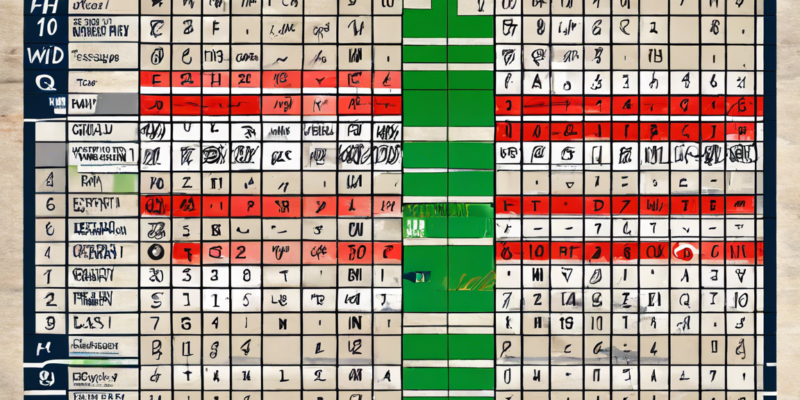Introduction
In the cricketing world, particularly in the T10 format, the comparison of teams is often centered around their performance in various metrics such as Strike Rate, Average and Economy Rate. Two dominating teams, the Super Champions League (SCL) and the Classic Champions of Modern History (CCMH), have been the subject of much debate and comparison regarding their success and statistical prowess in the T10 Blast cricket matches. This article aims to provide a detailed comparative analysis of both teams based on their scorecards in recent T10 matches.
Batting Statistics
When analyzing the batting statistics of SCL and CCMH, it is essential to look at their Strike Rates, Average Runs Scored, and Number of Boundaries per innings.
SCL: In recent T10 matches, SCL has displayed an impressive Strike Rate ranging from 160 to 180, indicating their aggressive and impactful batting approach. The team has also maintained a high Average Runs Scored per inning, often surpassing 100 runs. Additionally, SCL has consistently hit a significant number of Boundaries per innings, showcasing their ability to score quickly and efficiently.
CCMH: On the other hand, CCMH has also shown remarkable batting performances with a commendable Strike Rate of 150 to 170 in recent T10 contests. Their Average Runs Scored per inning has been competitive, frequently exceeding 90 runs. Moreover, CCMH has been proficient in hitting a considerable number of Boundaries per innings, highlighting their strong batting lineup.
Bowling Statistics
The bowling department is crucial in T10 matches, as it can determine the outcome of the game. Analyzing the Economy Rates, Bowling Average, and Wickets Taken by SCL and CCMH provides insights into their bowling effectiveness.
SCL: SCL’s bowling unit has showcased impressive performances with Economy Rates ranging from 6 to 7 runs per over, reflecting their ability to restrict opposition batsmen effectively. The team’s Bowling Average has been competitive, often below 20 runs per wicket, indicating their skill in taking crucial wickets. Additionally, SCL has consistently taken a substantial number of Wickets per match, underscoring their bowling prowess.
CCMH: Similarly, CCMH’s bowlers have been formidable, maintaining Economy Rates of 6 to 7 runs per over in recent T10 encounters. The team’s Bowling Average has been impressive, staying below 25 runs per wicket, showcasing their ability to dismiss batsmen efficiently. CCMH has also demonstrated a knack for taking crucial Wickets per match, highlighting their bowling depth and strategy.
Fielding and Miscellaneous Statistics
Beyond batting and bowling, fielding and other miscellaneous statistics play a vital role in determining a team’s overall performance in T10 cricket matches. Analyzing metrics such as Catches Taken, Run Outs, and Extras Conceded sheds light on SCL and CCMH’s overall gameplay.
SCL: SCL has exhibited strong fielding performances, often taking crucial Catches and executing precise Run Outs, contributing to their overall success on the field. The team has also managed to minimize Extras Conceded, showcasing discipline in their bowling and fielding efforts.
CCMH: CCMH, too, has shown proficiency in fielding, with players frequently taking important Catches and effecting crucial Run Outs to turn the tide of matches in their favor. The team has also displayed discipline in limiting Extras Conceded, reflecting their attention to detail in all aspects of the game.
Conclusion
In conclusion, the comparative analysis of SCL and CCMH based on their scorecards in recent T10 matches reveals that both teams possess strong batting, bowling, and fielding capabilities. While SCL has demonstrated an aggressive and high-scoring batting style, coupled with effective bowling and fielding performances, CCMH has showcased consistency and determination in all aspects of the game. Ultimately, the success of these teams in T10 cricket lies in their ability to perform cohesively as a unit and execute their strategies effectively on the field.
Frequently Asked Questions (FAQs)
- Which team has a higher average runs scored per inning, SCL or CCMH?
-
Both SCL and CCMH have competitive average runs scored per inning, with SCL often exceeding 100 runs and CCMH surpassing 90 runs on average.
-
What is the typical strike rate range of batsmen in SCL and CCMH?
-
Batsmen in SCL and CCMH usually maintain strike rates between 150 to 180 in recent T10 matches.
-
How do the bowling averages of SCL and CCMH compare?
-
Both SCL and CCMH have impressive bowling averages, typically below 25 runs per wicket in recent T10 contests.
-
Which team has a better record in terms of wickets taken per match, SCL or CCMH?
-
SCL and CCMH have displayed a knack for taking crucial wickets per match, underscoring their bowling depth and strategy.
-
How do the fielding performances of SCL and CCMH differ?
-
Both SCL and CCMH have shown strong fielding performances, with players taking important catches and effecting crucial run outs to contribute to their teams’ success.
-
What is the significance of minimizing extras conceded in T10 matches?
-
Limiting extras conceded is crucial in T10 cricket as it reflects the discipline in bowling and fielding efforts, preventing the opposition from gaining easy runs.
-
How do SCL and CCMH strategize differently in T10 matches?
-
While SCL adopts an aggressive and high-scoring approach, CCMH focuses on consistency and determination in all aspects of the game to secure victories.
-
Which team has a better overall win-loss record in recent T10 tournaments, SCL or CCMH?
-
The win-loss record in recent T10 tournaments for SCL and CCMH is relatively balanced, with both teams showcasing their competitiveness and skill on the field.
-
How do SCL and CCMH adapt to different pitch and weather conditions in T10 matches?
-
SCL and CCMH adjust their strategies and game plans based on pitch and weather conditions, utilizing their strengths to capitalize on the situation and outmaneuver their opponents.
-
What role does team spirit and camaraderie play in the success of SCL and CCMH in T10 cricket?
- Team spirit and camaraderie are crucial in fostering cohesion and synergy among players, enabling SCL and CCMH to perform cohesively as a unit and achieve success in T10 cricket matches.



Comments